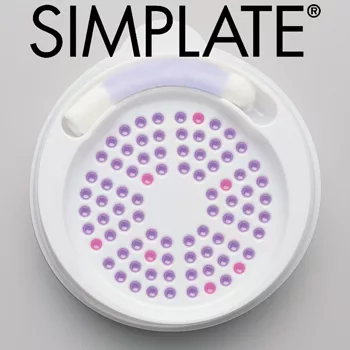SimPlate®, an Improved Counting Method

Ongoing occurrences of foodborne illness and spoilage have heightened the awareness of food microbiology, particularly the need for rapid bacteriological tests. Total plate count (TPC) and yeast and mold are among the most frequently conducted microbiology tests for quality assurance, as the presence of these organisms reflects the quality of raw product and processing, handling, and storage conditions.
There is a recognized need for more rapid enumeration systems for these organisms that allow faster response times to potential food quality or food safety problems. Current standard methods require 48- to 72-hour incubation periods for TPC and 5–7 days for yeast and mold before results are available. These methods come with inherent problems such as overgrowth of bacterial colonies, making it difficult and often impossible to determine an accurate number of colony-forming units (CFU).
Extensively Validated
The SimPlate system from MilliporeSigma was developed to overcome these limitations. Three assays from the SimPlate family are approved as AOAC Official Methods of Analysis: SimPlate for Yeast and Mold Color Indicator (YM-CI: AOAC Official Method 2002.11), SimPlate for Total Plate Count-CI (TPC-CI; AOAC Official Method 2002.07), and SimPlate for Coliforms and E. coli (CEC-CI; AOAC Official Method 2005.03). Both YM-CI and TPC-CI assays are also validated by MicroVal in accordance with ISO 16140. These tests offer a validated solution for faster results without the inherent limitations of plating.
SimPlate TPC-CI was extensively validated in a methods comparison study conducted among 19 laboratories representing governments as well as private industry in Europe and North America. It was validated against both BAM and ISO reference culture methods. Results demonstrated that TPC-CI was equivalent to both culture methods. Similarly, SimPlate YM-CI was validated in a methods comparison study and a collaborative study conducted among 17 laboratories. It was also validated against both BAM and ISO reference culture methods and found to be equivalent to both.
Easy to Use
The SimPlate system consists of a patented SimPlate device and proprietary media. The system uses a proprietary detection method based on Binary Detection Technology™ (BDT). BDT is a unique method for quantifying bacterial load. With the device, foodborne microorganisms are suspended in a nutritionally defined growth medium. Discrete aliquots are separately compartmentalized from each other in the 84 incubation wells of the device, where metabolism of viable microorganisms is monitored in a liquid environment.
Microorganisms are enumerated by counting the number of positive wells in the SimPlate device exhibiting a color change (positive well) after incubation. Simply note the background color (medium + sample = background color) prior to incubation. All wells that result in a color change different from the background color are considered positive. For example, if there are seven positive wells, refer to the SimPlate Conversion Table which shows that seven positive wells equals a population of 14. To determine the number of total organisms, multiply the population by the dilution factor.
The unique design of the SimPlate device provides a counting range of 738 CFU vs. 300 bacteria or 150 fungi on traditional agar plates. This is more than double the counting range of agar methods. As a result, the number of dilutions and reruns caused by uncountable plates is minimized, saving labor, time, and material costs.
Faster Time-to-Results
Another key advantage of the SimPlate system is faster result time. SimPlate YM-CI produces results in 56–72 hours compared with 5 days required by traditional plating methods. Results from SimPlate TPC-CI are available in 24 hours, while other methods require 48 hours. Faster result time means faster response time to food quality or safety issues and allows products to be released sooner, thus saving time and money.
The SimPlate family also includes tests for Campylobacter and Enterobacteriaceae. For use with difficult matrices, there are SimPlate media available for TPC and yeast and mold, which use a fluorescent media for enumeration. This method allows for detection in matrices that are highly colored or dark products with a 366-nm UV light.
For all laboratories that routinely need a robust and easy-to-use quantitative method for quality assurance, the SimPlate system provides an easy-to-use, extensively validated, and robust method for rapid enumeration.
For more information, please visit sigmaaldrich.com
Looking for quick answers on food safety topics?
Try Ask FSM, our new smart AI search tool.
Ask FSM →







.webp?t=1721343192)
